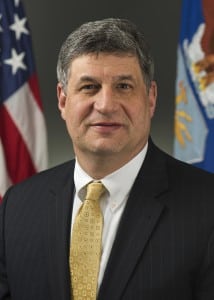The nominee to serve as the Pentagon’s next top acquisition official told lawmakers Tuesday his immediate priorities would include accelerating delivery of equipment to Ukraine and working to ensure “hot production lines” are running to replenish withdrawn munitions stocks.
William LaPlante told the Senate Armed Services Committee (SASC) during his confirmation hearing to be under secretary of defense for acquisition and sustainment he plans to also focus on more rapidly transitioning advanced technology projects from research and development into production and emphasizing modularity for major programs.

“If confirmed, one of my first things to do on day one would be to accelerate all equipment and capabilities to both the Ukrainians, as we agreed to, and also helping our NATO partners and to replenish our stockpiles,” LaPlante said.
Sen. Jim Inhofe (R-Okla.), the SASC ranking member, asked LaPlante if he believed there’s a need for the U.S. to make investments this year to expand production of key munitions, such as Stinger missiles, that have been drawn down to provide security assistance to Ukraine.
“I believe we need multiple hot production lines, whether it be [for] munitions, UASs and the like,” LaPlante said in response.
The leaders of the House Armed Services Committee have urged the Pentagon to establish a plan for replenishing the department’s stockpile of Stinger missiles that’ve been transferred to Ukraine, to include pushing for rapid development and fielding of a new short range air defense (SHORAD) system (Defense Daily, March 18).
The U.S. has committed to transferring 1,400 Stinger missiles to Ukraine to date, including 800 as part of a new $800 million military equipment package President Biden detailed last week in support of Kyiv’s ongoing effort to fend off Russia’s invasion of the country (Defense Daily, March 16).
LaPlante, who previously served as the Air Force’s top acquisition official during the Obama administration, would be the first permanent acquisition chief at the Pentagon since the start of the Biden administration.
“Dr. LaPlante, you’ve been nominated to be the department’s top acquisition [official]. It’s a shame it took a whole year because you’ve got a lot of catching up to do. Congress and the Pentagon working together have made huge strides in acquisition but the Chinese are still moving faster than we are,” Inhofe said.
During his confirmation hearing, LaPlante told the panel his second immediate priority would be addressing the Pentagon’s ability to get more technologies from development into production to ensure the U.S. retains its advanced capability edge.
“We’ve got to get those capabilities rapidly into the weapon systems and bridge what they sometimes call the ‘valley of death.’ So I pledge to work with the program offices to make it their job to do continuous upgrades of technology so we can come back into this race that you talked about,” LaPlante said. “If we don’t get things into a production line, then we’re not succeeding. That’s what we have to do.”
LaPlante said he would specifically focus on bolstering public-private partnerships and engagement with “innovation ecosystems” to bring in smaller, innovative companies to work with the department.
“What I plan to do, if confirmed, is really accelerate these public-private partnerships that are happening around the country and make sure that we are out there explaining our problems to industry and academia and also showing them that, hey, there’s hope if we fund you, that we’re not just funding you for your prototype, but you can have a line of business. If it’s successful, we can get it into a production line. I think that last piece has been what’s missing,” LaPlante said.
LaPlante also told the panel he believes emphasizing modular open systems architecture for major programs will enable enhanced innovation and rapid integration of new advanced capabilities being worked out of the R&D projects.
“Once you have the open system, then we can be upgrading with technology very fast. And the technology that matures will earn its way on and you have continuous upgrades. It can be done,” LaPlante said. “We’ve known about modular systems for 20 to 30 years. We need to get them into all of our new systems and put it into the RFPs.”